The ruggedly beautiful Aspromonte National Park covers much of the bottom third of Calabria, the province that makes up the toe in Italy’s boot. Chris Allsop took a trip to this dramatic and often unfairly overlooked part of the country’s south.

“They are like a net,” my guide in the city of Reggio Calabria told me, after I asked her about whether the ‘ndràngheta mafia was still strong in this area. “Built of tight family bonds. That’s what makes them so difficult to break up.”
I hadn’t expected this response. There have been so many apparent successes against various mafia groups in Italy that it’s easy to assume that they’re a spent force.
Apparently not in Calabria, the mountainous toe of Italy’s boot and home to two million inhabitants, mostly clustered around its gorgeous 780km coastline.
The guide reassures us that foreigners aren’t the target of the ‘ndràngheta, that the organisation appreciates visitors, and that, in fact, “If you were to leave your bag behind, someone would come running to return it.”
I agree it’s a reassuring thought (sort of), but perhaps not worth testing. It seems the ‘ndràngheta remain a fact of life in southern Italy, but so does gelato, sparkling seas, and charismatic topography, so best to focus on the latter trio and put the other out of mind.
Oft-ignored province
I’d arrived at Reggio Calabria airport – a one-luggage-belt operation – for a couple of days of exploring this oft-ignored southerly province that hadn’t developed Puglia’s pull, or leveraged its heritage as successfully as neighbouring Basilicata.
Reggio Calabria, a city of just under 200,000 people (the largest in the region), turned out to be cut from the same vivacious cloth as most seafront cities in Italy, except for one significant addition: the view from the broad, palm-shaded promenade of the Sicilian coastline across the Strait of Messina, the heat haze softening the contours of the neighbouring island’s green hills.
Though I was keen to delve into Calabria’s rugged hinterland, I made time to stop into the National Archaeological Museum of Reggio Calabria. This is a light and airy exhibition space over several floors, with the Riace bronzes – two statues of ancient Greek warriors – as the worthwhile culmination of your tour.
The bronzes had lain on the bottom of the sea for 2,000 years and were found, by chance, by a scuba diver only metres from the beach. They’ve been restored many times, and the museum is taking no chances with any further corrosion: prior to entering the bronzes room, there’s a kind of decontamination chamber with a red light that gets the pulse racing.
The bronzes are a reminder that the Greeks established a strong presence in southern Italy, their advance up the Peninsula halted by the equally advanced Etruscan civilisation. This is a large part of why southern Italy has such a different feel, culturally, to the north. Even the word ‘ndràngheta is Greek, translating roughly as ‘men of value’. But we’re not thinking about them, are we?
Leafy orchards
The next day, I leave for a day trip around the park. As my guide and I pass out of the city limits, travelling anti-clockwise on the 106 South coastal highway, long stretches of shale and sandy beaches are fringed by the calm Ionian Sea. My guide informs me that the Ionian side is, as a rule, warmer than the Tyrrhenian side, but also generally windier.
The beaches seem entirely deserted, as does the rough interior forming the park’s core, its dry chaparral-scape reminding me of the hills of southern California. As the landscape moves on, ‘rough’ ratchets up to ‘cataclysmic’ as the Jerome Flynn-craggy Aspromonte massif rears up to its full 2,000 metres, while order continues to reign on the foothills below, where leafy orchards dominate.
Calabria is the epicentre for bergamot production in Italy, with some 1,500 hectares – mostly found on the lower slopes of Aspromonte mountains – producing this celebrated cross between a bitter orange and a lime that gives Earl Grey tea its fragrant flavour.
The name of the fruit, a derivation from Turkish that translates as ‘pear of God’, is another nod to the overlapping cultural weave that is the Mediterranean. Bergamot products and cuisine are abundant in this region, and the fruit makes for a particularly crisp and delicious sorbet at the end of a meal.
Our first stop is Villa Romana – an archaeological park roughly an hour and a half from Reggio Calabria. Uncovered in 1954, this extensive site is still not completely unearthed. Anywhere else in Italy, at around midday, you’d expect a place like this to be overrun with tourists, but today it’s only me.
The elaborate mosaic floors, with highlights including nereids and a detailed mosaic portrait considered to be the villa’s owner, are mostly intact and still retain much of their original colour. Mosaic borders of prized Egyptian red marble suggest the wealth of this villa’s owner, who was probably engaged in the wine trade at the time.
This area, near the town of Bianco, has long produced wine. Just a few minutes down the road, we stop into the verdant farmstead of a passito producer, his buildings surrounded by flourishing olive and bergamot trees, all offset by the surrounding bleached mud hills dominated by willowy eucalyptus. Passito is similar to Tuscan Vin Santo, but the Greco Bianco grapes (brought over from Greece in the 8th century) used in the production of this Calabrian version are grown only in this area of the province.
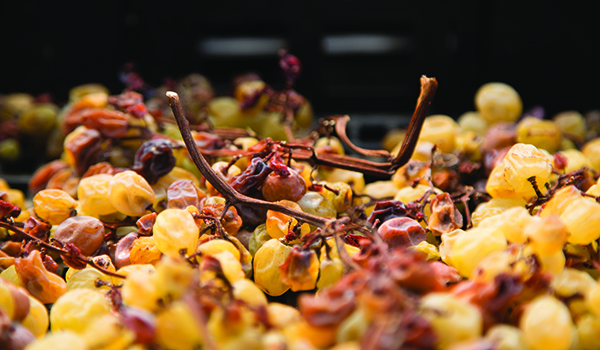
The wine producer, Flavio, whose label goes by ‘Tenuta Dioscuri’, takes me on a tour of his organic wine operation.
We pass immense, velvety roses blooming beneath the bright October sun (I’m informed that the blooms persist until December). Deflated grapes, giving off a heavy raisin scent, sit in stacked crates drying in the heat, a key part of the passito production process.
The finished product is a light and quaffable dessert wine that we taste together in the shade of his old farmhouse, the wine accompanied by calabrucci biscuits (a sugar-coated cookie). With bottles only €10 at the winery, it’s a bargain compared to the €40 that local restaurants would charge you. I make my acquisition.
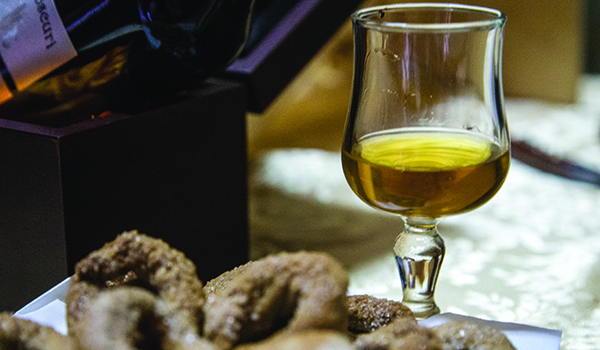
Our next stop is lunch, at the Azienda Agricola Barone GR Macrì agriturismo located deeper in the park proper. We turn off the coastal road and into the mountainous interior that, on days not as warm as this, makes for fabulous hiking. Cactus trees stretch their fingers skyward, and climbers scramble over ruined walls spotted with magenta flowers. On our right, perched high on a plateau above sheer cliffs, Gerace. It might just be the passito, but the town’s positioning puts me in mind, fleetingly, of the Acropolis. With few traces of modernity, the weight of the region’s ancient history lies heavy in these valleys, the landscape of pine, olive trees, and cactus both forbidding and arresting at the same time. We drive across a small bridge, where long-haired goats grubbing in the dried-out watercourse glance up at us from below.
Clever sparrow hawk
A member of Italy’s borghi più belli d’Italia (the organisation of the most beautiful villages of Italy) – Gerace derives its name from the Greek ‘jerax’, which was the word for the sparrow hawk that apparently showed the early settlers where they should situate their town in order to protect it from seaborne raiders. Clever jerax.
It’s also well protected from tourists, as you have to park outside and take a gaudy tourist train up the snaking approach road. It’s Saturday, so inside the town Italians are getting married. Old women in towering heels totter carefully across the cobbles towards the Cattedrale di Gerace, a beautiful building that’s robust on the outside and contrastingly delicate within.
The history here is extraordinary, with a ruined Norman castle at the town’s apex and a small square, further into the heart of the town, bordered by a striking trio of religious buildings boasting contrasting styles of architecture. I duck into the 13th-century Church of Assisi’s Gothic entrance to find a remarkably bare interior, perfect for showing off the extraordinarily ornate altar. The plastic lawn chairs laid out for the congregation add a touch of the bizarre.
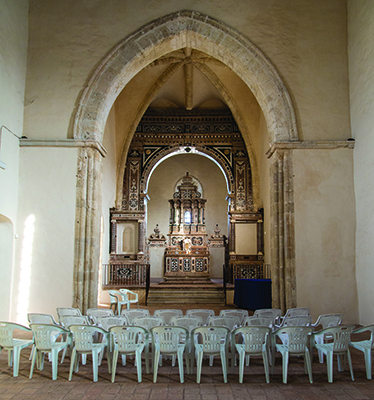
Through the cool, deserted alleyways draped in grape vines, I find my way to Piazza del Tocco, where at last I complete my obligation to my brother and purchase some ‘nduja, the spicy spreadable sausage meat from Calabria that’s become a surprising sensation among British foodies. I pick up a stracciatella and pistachio gelato to congratulate myself on my find, only to be bemused by the small bun that my server slaps on top of the ice cream. As a professional journalist, I try the bun. It does not improve the ice cream. I ditch the bun.
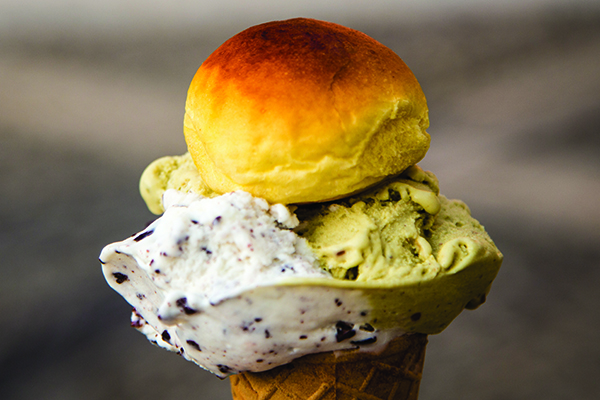
The walk down the other side of Gerace is almost as lovely as the drive up, with the furthest extent of the town a puzzle of ruddy-tiled roofs below. Graves populating the far cliff edges look like suburbs of austere doll’s houses. It is all so peaceful and unspoilt.
We begin our drive back to the coast. As I peer back at the mountains, the sun silhouettes a house on a ridge, the light shining through three windows; whether the structure is half built or half ruined is impossible to see. It’s approaching late afternoon, and we’re making our way to Scilla, on the tourist-friendly Costa Viola – a lantern-lit waterside enclave with restaurant terraces projecting over the water on tiny, bright piers.
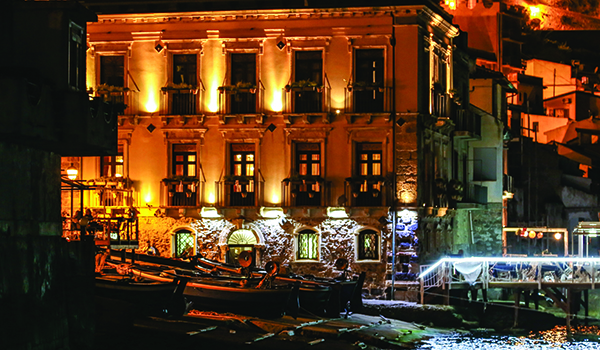
After seeing Aspromonte, with nature growing into ruined farmhouses and the stone of the buildings and the land bleached into harmony, Scilla seems to belong to another place. The mystery of Calabria, entangled in its history, is always deepening
